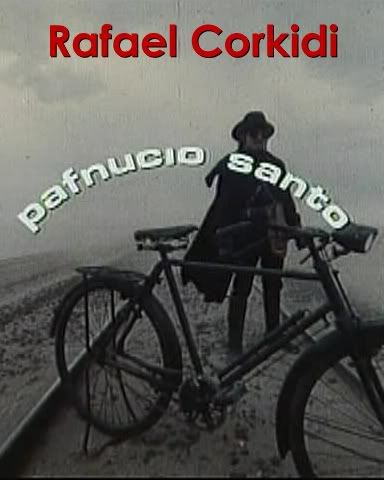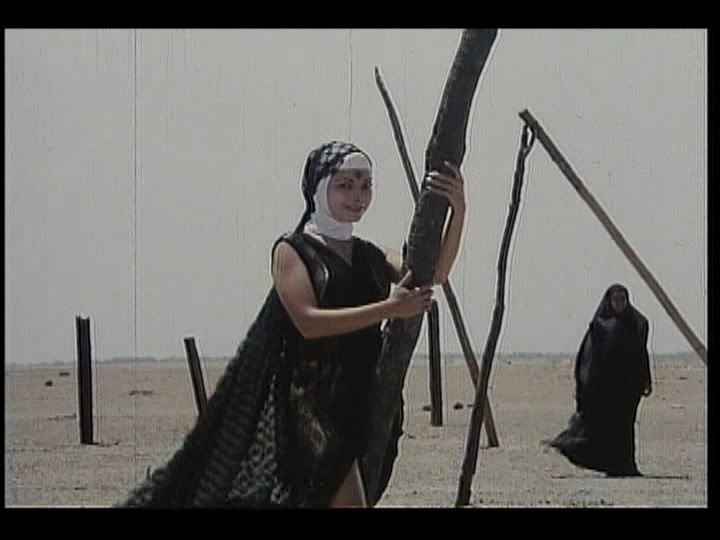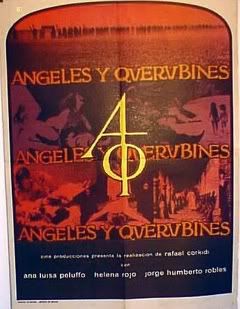
Kakvi bi filmovi mogli nastati kada kamerman Alejandra Jodorowskog počne režirati?
With his unfinished Marxist Mexican celluloid odyssey ¡Qué viva México! (1932), homo Bolshevik auteur Sergei M. Eisenstein (Battleship Potemkin, Alexander Nevsky),
despite failing to fully realize his artistic vision, essentially
planted the seeds for all avant-garde and largely far-left Mexican (and
sometimes Spanish) films to come, especially in regard to
surrealist/acid westerns like Alejandro Jodorowsky's El Topo (1970) aka The Mole and Fernando Arrabal’s Long Live Death (1971) aka Viva la muerte. Undoubtedly, if any of these follows the most closely thematically to ¡Qué viva México! in terms of its anti-colonial sentiment and call-to-commie-arms sociopolitical spirit, it is surrealist quasi-western Pafnucio Santo (1977) directed by Rafael Corkidi (Angels and Cherubs, Desires aka Deseos). Best remembered today as the cleverly calculating cinematographer behind the stunning camera work in Jodorowsky's Fando y Lis (1968), El Topo, and The Holy Mountain (1973), as well The Mansion of Madness (1973) directed by Juan López Moctezuma and Anticlimax
(1973) directed by Mexican Renaissance man Gelsen Gas, Rafael Corkidi
and his films, which are virtually impossible to find by any legal and
official means, have undoubtedly been dropped in the garbage heap of
surrealist cinema history, which is indubitably a minor cinematic
tragedy of sorts, if not a surprising one considering the somewhat
impenetrable, compulsively artsy fartsy, and overwhelmingly non-linear
nature of these works. Rather absurdly chosen as the Mexican entry for
the Best Foreign Language Film at the 50th Academy Awards but ultimately
not being accepted as a nominee, Pafnucio Santo—a
terribly pretentious peasant pseudo-Biblical tale—is a sometimes ominous
and always odd operatic hodgepodge of nauseating nudity (including
unclad old men and little boys, including the director's son) and
demonic erotic dances, unadulterated anti-Americanism, minor
Nunsploitation, sardonic anti-Catholicism, mystifying Mexican folk hero
worship, Makavejev-esque communist criticism from the left, and
quasi-high-camp of the Hispanic sort. Featuring a number of characters,
who are sometimes in drag and played by the same actors, lip-synching
to popular opera (sometimes in German!), Pafnucio Santo
is undoubtedly a work that owes much credit to arthouse camp/kitsch
auteur filmmakers of German New Cinema, especially Werner Schroeter (Eika Katappa, Der Bomberpilot), Hans-Jürgen Syberberg (Ludwig: Requiem for a Virgin King, Hitler: A Film from Germany), and Ulrike Ottinger (Freak Orlando, Johanna D'Arc of Mongolia),
thereupon making it a work that stands far enough apart from the films
of Jodorowsky and Arrabal as a curious celluloid cultural mongrel of
sorts despite its somewhat militant Mexican power message. Centering
around a sort of preteen Mexican Marxist messiah/revolutionary, Pafnucio Santo
follows the (un)holy ‘Hispanic’ hero through history as he plays stupid
American football in Aztec ruins, talks to his spiritual mother Frida
Kahlo, and discovers that Patty Hearst is a big bitch and nihilistic
misanthrope who is not a true red Marxist revolutionary.
Told in operatic surrealist segments (journey, visitations, vespers,
revolution, etc.) that vary in quality but are virtually always visually
entrancing, Pafnucio Santo begins with the introduction
of a dark emissary (Juan Barrón), who resembles a cross between Che
Guevara and Leon Trotsky, has flames flashing from his face, and sports a
militant uniform that looks like a cross between that of a fascist
blackshirt and those worn by the killing squads that belonged to the
Soviet Cheka. Upon running into Adam and Eve, the dark figure
criticizes them for covering their genitals, thereupon criticizing the
anti-life/anti-sex dogma of the Catholic Church that has spiritually
castrated horny Mexican peasants. When seeing Jesus Christ die on the
cross in the desert, the dark revolutionary pays him no mind, but he
sneers with vile hatred when seeing a deadly crew of Klu Klux Klanners
carrying a large burning cross, shotguns, ropes, and chains. The dark
emissary also watches in disgust as a group of Jewish women and children
are led through a gate with the infamous Auschwitz quote “Arbeit macht
frei” (“work makes (you) free”), which was undoubtedly a German joke
against the Jews and communists that director Rafael Corkidi certainly
does not find funny as a true believer of the Gospel According to St.
Marx. The black-caped emissary is here to make sure that a young
football-tossing boy named Pafnucio Santo (the director’s son Pablo
Corkidi) aka Holy Pafnucio is able to find a Marxist
anti-Mother-Mary-like woman to give birth to a new Red Messiah of the
Mestizo revolution. When preteen prophet Pafnucio meets with degenerate
communist artist Frida Kahlo, she sings to the little lad, “The
Party ordered you to look for the mother…who has the people’s struggle
in her blood…because the red Messiah is about to be born. He will be,
like Lenin, a great leader, a bold fight. A titan of the future!,”
and the boy bolshevik goes on his merry way to find the potential mother
for Jesus Marx. Pafnucio also encounters Spanish Conquistador Hernán
Cortés, the man who crushed the Aztec empire and helped form the
mongrelized multicultural nightmare that Mexico is today, singing in a
pigsty in an allegorical scene that demonstrates that the director
thinks the conquistador was a pig who turned the Aztec lands into a pile
of pig shit. When Pafnucio runs into a lady named ‘Patty Kane’ (a
reference to Patty Hearst and Orson Welles’ Citizen Kane,
the film that defiled the heiress’ grandfather William Randolph Hearst's
legacy), he finds her to be a ‘red fascist’ (as his comrades goosestep)
and nihilistic misanthrope as demonstrated by her singing of the
following lines, “I hate people, I love war! Everything makes me sick, in this world!,”
thereupon making her an excellent candidate for being the Mother of
Mexican Marxism. Pafnucio also runs into hostility from a
stereotypically Mexican folk dancer, who states hatefully after the boy
compliments her Mexican hat dance skills, “The little dance that you
like so much, and I’ve been dancing all my life, is a plague! It’s what
they call “nationalism”, “patriotism”…and I used it to get fucked! The
Jarabe Tapatío is for everyone and everything, yes sir!,” which
rather upsets the wee lad. Little Pafnucio also has a marvelously
melodramatic time viewing a Teutonic opera performance of William
Shakespeare’s classic tragedy Romeo and Juliet, but only
when meeting Emiliano Zapata in drag (played by Gina Morett, who plays
at least two more characters in the film), who looks quite fine whilst
wearing nothing more than a a vest of shotgun shells, does he seem to
discover his Marxist Mother Mary and is able to shed his American
football uniform forever.
A work that, while retaining the original lyrics of classic opera
compositions, features totally different subtitles with stupidly
stereotypical revolutionary lines like “red star of gleaming red” and “Mexicans, heed the cry of war! Awaken!,” Pafnucio Santo
is essentially an aberrant and absurdist agitprop flick that performs a
sort of reverse-colonialism, aesthetically raping and pillaging
classical European culture. Considering that the largely left-wing
Mexican-Americans of California elected Republican Arnold Schwarzenegger
governor of California simply because he is the Terminator, it is
highly doubtful that such an art-addled work as Pafnucio Santo
would have entertained them, let alone inspired the everyday Jose
Schmose Mexican proletarian to take revolutionary political action.
Featuring American football players playing an aggressive game in
ancient Mexican monuments set to musical compositions by Richard Wagner
and a young revolutionary who likes to dress like a cliché brainwashed
American slob with a football helmet and Mickey Mouse t-shirt, Pafnucio Santo
basically takes the stance that not only did the Spanish destroy the
ancient Aztec gods and indigenous culture, but that cultural colonialism
still lives on today in Mexico via Americanization/globalization.
Despite its superficial aesthetic and thematic similarities with the
films of Jodorowsky, Pafnucio Santo is ultimately a
different breed as a Heimat film for Hispanics who hate the word
‘Hispanic’ and dream of the return of the Mesoamerican deity of war
Huitzilopochtli and the destruction of Amero-gringo hegemony.
Undoubtedly a work that derives its greatest strengths from its
iconoclastic imagery and propensity for making KKK lynch mobs and Hebrew
tots being led to the gas chamber seem like an exceedingly ethereal
nightmare of the abhorrently aesthetically pleasing sort, Pafnucio Santo
is best seen today as a failed yet oftentimes enthralling piece of
novelty celluloid concept (anti)art deserving of minor cult status.
More militantly idealistic than the celluloid magic tricks and jestering
of Jodorowsky, Pafnucio Santo is also a work of Third
World propaganda cinema that slightly rises above the level of simple
commie clichés, even if the work is ridden with such vomit-inducing
Trotskyites banalities. The closest thing to a Mexican Hans-Jürgen
Syberberg, Rafael Corkidi proved with Pafnucio Santo one
can still hate a people/culture (i.e. Europeans), but respect them at
the same time as demonstrated by the director's use of musical
compositions by Anton Dvorak, Edvard Grieg, Antonio Vivaldi, Richard
Wagner and Giaccomo Puccini, as well as his curious nods to Shakespeare
and Orson Welles and undeniable influence from European arthouse cinema
of the late-1970s. A film that will certainly be of interest to those
oh-so few ‘Brown Power’ cinephiles and the white nationalist cinephiles
that hate them and would like to study the psyche of the enemy, Pafnucio Santo
is political propaganda at its most patently perverse as a sort of
bootlegged made-in-Mexico Mestizo brother film to Makavejev's Sweet Movie (1974). Described in a 1977 New York Times review as being, “a
bit like a homemade backyard shrine, admirable for what it says about
the builder's capacity for compassion, regrettable in its confusion of
prettiness for high art,” Pafnucio Santo is nothing
short of amazing proof that even gringo-hating Mexicans can be pompous
art fags who can have an exaggerated sense of prowess as cultural
critiques. Of course, if a race war occurs in North America and
Mexicans and other Amerindians either win or establish their own
ethno-nationalist racial state, I hope at least that Pafnucio Santo
and director Rafael Corkidi's other films are rediscovered and
acknowledged as true Mestizo art, but I seriously doubt it as the film
lacks a certain machismo spirit. After all, I doubt many masculine
Mexicans would of approve of their hero Emiliano Zapata depicted with
tits and no cock, but I would say I respect Corkidi for inventing a sort
of Schroeter-esque form of Cholo high-camp. -Soiled Sinema



Ángeles y querubines (1972)

Auandar Anapu (1975)

Deseos (1977)

Corkidi, of course, is best known as a cinematographer, and I’ll be the first to admit his prodigious talent for lighting and composition borders on genius. It’s appropriate, then, that Corkidi remains best known for four films he photographed but didn’t direct. Regarding the features he did helm, the best I can say about them is that all are extremely well visualized.

The same is true of Alexandro Jodorowsky’s EL TOPO and THE HOLY MOUNTAIN, and Juan Lopez Moctezuma’s MANSION OF MADNESS, all of which benefited immeasurably from Corkidi’s visuals. The desert-set EL TOPO in particular bears Corkidi’s fingerprints in its impeccably visualized surreal set pieces that directly foreshadow his self-directed features. Corkidi’s work on THE HOLY MOUNTAIN, alas, was apparently marred by friction with Jodorowsky, who claims that Corkidi “was a nice person when we made EL TOPO…then when we made THE HOLY MOUNTAIN he was very difficult to control,” and alleges Corkidi even tried to “sabotage” the film. As for THE MANSION OF MADNESS, Corkidi’s bold cinematography was integral to that film’s overpowering aura of surreal insanity.
Of Corkidi’s self-directed features, Jodorowsky has claimed they were all directly inspired by EL TOPO, and dismissed them as “boring.” I’m not entirely sure I agree with the first statement, as Corkidi clearly had a style and point of view that were very much his own (although at least one of his films does owe a sizeable debt to Jodorowsky), yet on the second Jodorowsky is entirely correct, as boring is one thing the following films indisputably are.

Quite simply, the film is a bore. Virtually every scene is allowed to drag on far longer than is necessary, regardless of how uneventful those scenes may be (watching a servant woman endlessly circle a dinner table doling out soup is about as interesting as it sounds), and there’s little in the way of a cogent narrative to hold it all together. The film is crammed with striking surreal touches (telepathic puppets, an elaborate religious procession in the middle of a parched desert), but they feel gratuitous. Yet the cinematography, accomplished by Corkidi himself, is stunning.

Corkidi evidently had EL TOPO in mind, even though the film was allegedly based on a Mexican folk tale. Also, the surrealism usually so integral to Corkidi’s style has been toned down here, leaving us with an impressively photographed but quite tedious effort.


Most of the remainder of Corkidi’s filmography consists of TV documentaries and a handful of little-seen features (including 1984’s long-banned FIGURAS DE LA PASION, 1992’s RULFO AETERNUM and 2010’s EL MAESTRO PRODIGIOSO). Currently entering his ninth decade and evidently retired, Corkidi can be viewed as one the greatest cinematographers Mexico has produced. His skills as a director, alas, aren’t in the same league!
- www.fright.com/edge/RafaelCorkidi.htm






Nema komentara:
Objavi komentar